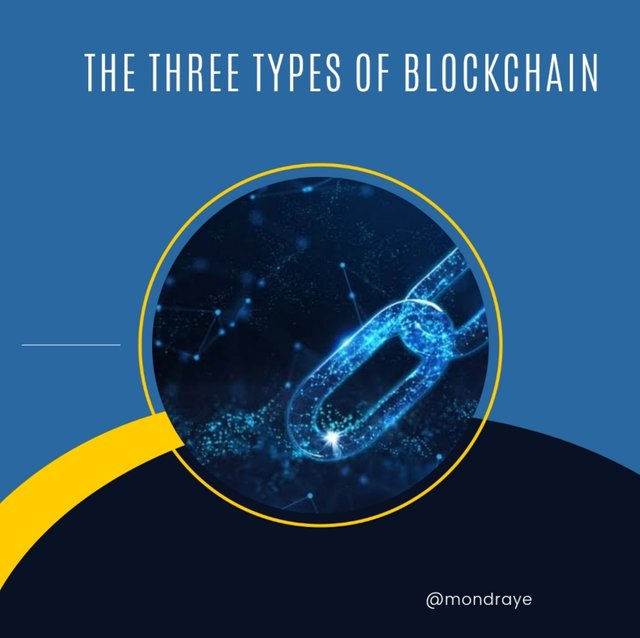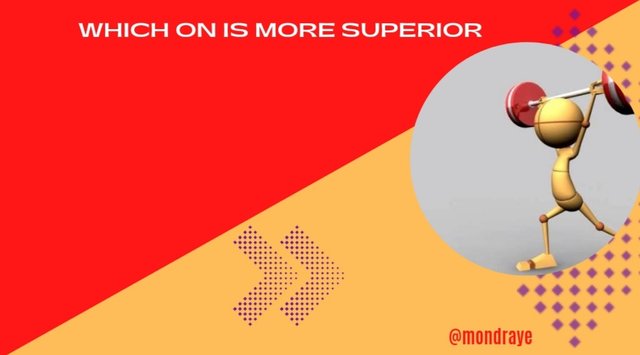THE THREE TYPES OF BLOCKCHAIN
When Bitcoin was first introduced, it created the groundwork for an industry centered on the blockchain technology that powers the protocol. Eager innovators have recognized the technology's potential and are testing it in every field imaginable.
A blockchain is a simple data format that can only be extended rather than altered. It can help to think of it as a spreadsheet, with each cell pointing back to the preceding one, making any attempt to change an earlier cell obvious. A blockchain is most commonly used to keep information about financial transactions, but it can also be used to store any other type of digital data. It can simply be regarded as a digital ledger.

Blockchain have been very popular amongst cryptocurrency users which I know all of us here are familiar with. But one thing I know is that not all of us are aware of its different kind which is what that has led me into compiling this lesson.
On this lesson, we will be looking at the different kinds of blockchain which are private, public, and consortium.


Private blockchains, in contrast to public blockchains, have restrictions controlling who may see and write to the chain (they're permissioned environments). There is a clear hierarchy of control in these systems, hence they aren't decentralized. However, they are distributed in that many nodes still keep a copy of the chain on their workstations.
Private chains are more suited to enterprise settings, when a company wants to benefit from blockchain qualities without exposing its network to the public.
Proof of Work is inefficient, but given the security model, it has proven to be vital for an open environment. In a private blockchain, however, the risks that PoW prevents aren't as serious because each participant's identity is known and governance is in the hands of the participants.

You've probably dealt with a public blockchain if you've used a cryptocurrency recently. The vast majority of distributed ledgers in use today are made up of these components. We call them public because anyone can view the transactions, and joining is as easy as installing the relevant software.
The terms permissionless and public are frequently used interchangeably. There are no barriers to participation, and anyone can participate in the consensus system (for instance, by mining or staking). We may expect a highly decentralized topology on a network built around a public chain because anyone can join and be rewarded for their contribution to reaching consensus.
A public blockchain, similarly, should be more resistant to censorship than a private blockchain (or semi-private one). Because anybody can join the network, certain protections must be included in the protocol to prevent malevolent actors from gaining an advantage while remaining anonymous.

The consortium blockchain straddles the public and private blockchain divide. The most significant distinction between the two systems can be seen at the level of consensus. Instead of an open system in which anyone can validate blocks or a closed system in which only a single entity selects block producers, a consortium chain employs a small number of equally powerful parties to serve as validators.
The system's regulations are then flexible: the chain's accessibility can be restricted to validators, made visible to approved individuals, or made visible to everyone. Changes can be deployed out quickly if the validators reach an agreement.
When it comes to the blockchain's operation, as long as a specific number of these parties are acting honestly, the system will run smoothly.

| PRIVATE | PUBLIC | CONSORTIUM |
|---|---|---|
| Private blockchain is not permissionless | Public blockchain is permissionless | Consortium blockchain is not permissionless |
| Only invited users can read on private blockchains | Anyone can read on public blockchains | The ability to read on consortium blockchain varies |
| Owned by a single body | Owned by nobody | Owned by multiple persons |
| Users are not anonymous | Users are anonymous | Users are not anonymous |
| Transaction speed is fast | Transaction speed is slow | Transaction speed is fast |
| Only approved users can write on private blockchain | Anyone can write on Public blockchains | Only approved users can write on consortium blockchain |


✅Censorship resistance is a strong suit for well-designed public chains, but speed and throughput suffer as a result. These are the greatest options for increased transaction security assurances (or smart contracts).
✅A private blockchain focuses more on the speed of the system. It is mostly used in cases whereby an organization needs to maintain ownership while keeping information private.
✅Consortium chains eliminate some of the counterparty concerns associated with private chains (by removing centralized control), and their reduced node count allows them to function far better than public chains. Organizations that wish to communicate more efficiently with one another are likely to be drawn to consortiums.

We have come to the conclusion of today's lesson and I believe that if you have followed up well you will be clear on the various kinds of blockchain and their differences.
10% to @Tron-Fan-Club
Omo nobody drop crypto post reach you. Your hustle no be here, I like that it's because of hardworking guys like you that the new steemians are staying motivated. I really enjoyed your lectures especially the part about public chains, I definitely learnt alot
Thank you for motivating me
Tweeter link
https://twitter.com/SonOfMaaan/status/1537465215700328448?s=19
Thank you for contributing to #LearnWithSteem theme. This post has been upvoted by @Reminiscence01 using @steemcurator09 account. We encourage you to keep publishing quality and original content in the Steemit ecosystem to earn support for your content.
Regards,
Team #Sevengers
Normally, this post is meant to be categorized under #fintech. Please use the right tag next time.
You have done a detailed explanation related to types of Blockchain such as Public, Private, and Consortium. Thank you very much for providing such educational articles.
I am happy that you have found it educative. Thank you
You are most welcome my friend. Your dedication should be appreciated. That's why I wanted to share my thoughts about it. Keep writing such interesting articles.
Thank you for discussing this because it is certainly one of the most interesting things to read
Thank you for your comment
Welcome bro
This is very interesting brother, I never new the three types of blockchain and thier comparison. Thanks for taking time explain this topic.
I am happy you learnt something new today